Dunkirk NY – This year I did not write a holiday letter for friends and family. I put out a call for end-of-year blurbs, but no takers. Everyone wants to edit what I write. So I decided – fuck it. I’ll just write my own update here on my blog, and whoever manages to find it and read it, well, I hope you had a good holiday. Here’s my 2022 in review.
I started the year off by taking a job delivering flowers with the local flower shop. They needed someone as a replacement driver to deliver flowers for one of their employees who goes to Florida every winter. AML happened to be in the flower shop and overheard the conversation, so she told me about it. I decided to take it because I thought getting out to go to a job would be mentally helpful, and it was. The schedule was easy because there are two drivers, and we work five days on and five days off. I worked until the first week in May. Some days it was difficult due to weather conditions, but it forced me to engage winter a little bit, and when you can go out and experience the day, you feel better. At least I did. I was all set to do it again this winter until AML had her surgery (see below), so taking care of her has meant giving up the job this winter. But I enjoyed the people and they seemed to like my work, so hopefully the 2023-24 winter I can take the job again.
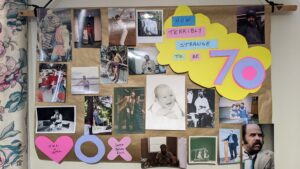
My 70th Birthday Poster
I turned 70 in February. It has felt like a significant number. I think it may warrant its own essay. Suffice to say there seem to be aches and pains that come with turning 70, as well as a noticeable decrease in the ability to do and recover from physical labor. It’s not as easy as it used to be.

A Full Dumpster
In March I cleaned out my office and threw away a lifetime of books. I filled a huge dumpster almost 3/4 full with books alone. Some of them were Tony’s books as well. I did not want to throw out the books, but I felt in the end I had no choice. No one wants books anymore.

Me, Marion, AML, Rocco
In May we went to LI to celebrate AML’s sister’s 75th birthday as well as attend a memorial service for her cousin Joyce. It was actually quite fun. AML caught up with a lot of her family, and we also caught up with our old neighbors from Woodhaven in the late 70s, Rocco and Marion. They were the best neighbors we’ve ever had, and they looked great! The 75th party went off very well, and Jackie felt very special. It turned out to be a pretty good trip.
I had two theatre gigs this year. Shakespeare in Delaware Park returned to doing two full shows, and I began rehearsal for Midsummer Night’s Dream, playing Bottom. This was a role I was supposed to do in 2020. I hung on to the part through the pandemic, in the belief that this was also going to be the last show Saul Elkin would direct. However, he turned 90, and he decided that working in the conditions on the hill would be too much, so he backed off from directing the show and turned it over to someone else. I decided to stick with it.
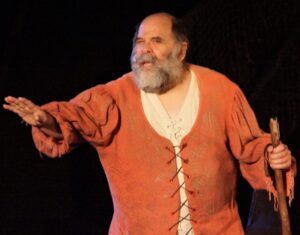
“I have had a dream”
Rehearsals began in mid-June, and the first real rehearsal nearly killed me. I was completely out of shape and unprepared for how exhausted I became. I think ordinarily you don’t want a 70-year-old Bottom, but since I felt committed to the role, I stayed with it. Working in Delaware Park is quite an exhausting task even under normal circumstances. For me, it’s an hour commute one way, so basically 100 miles of driving six nights a week. There is one day off, as the shows run Tuesday-Sunday. And unfortunately for me, about halfway through the run, just when I felt I had actually broken through the fatigue factor and my body had become acclimated to the physical routine, I slipped slightly on stage at the end of one performance and pulled my right hamstring muscle.
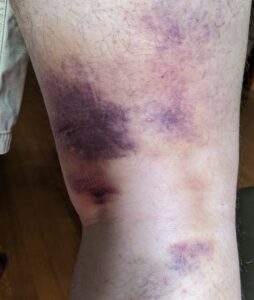
Injured hammy
I had to do about two weeks of the run now carrying a walking stick for support on stage, and icing in between scenes, not to mention taking a lot of ibuprofen and Motrin. I got through it each night, but in the end, I had mixed emotions. It was fun, yes, but the sheer physical effort took a good portion of the fun out of it. I came away with the belief that the summer of 2022 was my last summer on the hill. Even if any offered role was a relatively easy one, just the thought of 6 nights a week of a 100-mile commute on top of a nightly performance seems too much. I think it may be time to pass the torch to the younger generation and call it quits.
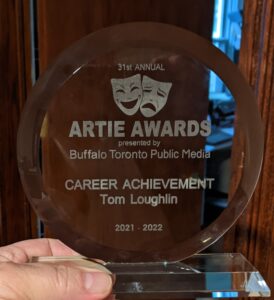 I did receive a Career Achievement Award at the Buffalo Arties in June, which was wholly and completely unexpected. I was honored for both my 30-year career in the community and also my career as an educator at Fredonia. It was kind of a shock, to be honest. I’m not a fan of awards, and I am not good being at the center of attention, but I got through the ceremony OK. It’s always nice to be appreciated for your work.
I did receive a Career Achievement Award at the Buffalo Arties in June, which was wholly and completely unexpected. I was honored for both my 30-year career in the community and also my career as an educator at Fredonia. It was kind of a shock, to be honest. I’m not a fan of awards, and I am not good being at the center of attention, but I got through the ceremony OK. It’s always nice to be appreciated for your work.

Cabin in the Woods
I made a lot of improvements on the land as well. I now have a new Amish-built shed which I will be using as a cabin in the future. It came in early July, but of course I was usually too tired and busy to enjoy it much. I did manage to get a floor installed before winter came. We also had the loft area of the RV repaired, so that makes the RV in better working condition than it had been. No trips, however. We got the RV up to the campsite for the summer, but it remained mostly unused. I just don’t have the physical energy or capability to do both a show and the work on the land. So the land remains as it is, but it’s now in much better shape I think. Unfortunately I ruined the Kodiak Canvas tent by leaving it up and letting the grass around it get too wet, creating bad mold. It was a stupid decision, and I regret it a lot. I want to replace the tent, but it’s too expensive, and I have made a resolution not to buy any more camping gear unless I absolutely need it. I have been buying things I think I will need, but then never use – a waste of money. I am attempting this coming year to avoid doing that, only buying items when I absolutely need them. I have plenty of outdoor gear as it is, and I need to put that to good use first before buying any more.

The Chosen
In late September I began rehearsals for my second show of the year – The Chosen, at the Jewish Repertory Theatre of Western NY. I played Reb Saunders, a Hasidic tzaddick whose son befriends an Orthodox Jewish boy in Williamsburg in 1942. I had played the other father, David Malter, a yeshiva teacher, 20 years ago. It had been the very first show of the JRT, and they were celebrating their 20th anniversary season with a remount. Saul Elkin co-directed the production; he had played Reb Saunders in the first production. Saul had offered me the part in March, and I had to grow my beard out as much as I could for 7 months. It got to be quite good sized, and I toyed with the idea of keeping it, since the look was so unique. But in the end I returned to my low-maintenance look, which I guess I prefer. A bit neater, and it’s easier to eat.
The show itself was very successful, but it was beset with a few issues. We had to cancel opening weekend due to two cast members getting Covid (as well as during rehearsals), so we lost performances there. Then Snovember 2.0 hit in Buffalo, which wiped out 2 performances. I had to get an AirBnB in Buffalo to be sure I had any chance of getting to performances. Because we lost all the shows, we added one more Sunday matinee just before Thanksgiving, a performance not originally scheduled, but which did sell out.
It’s also apparent that Covid-19 is still out there, as a planned Thanksgiving week in Oneonta with Brian and his family was ruined by Brian getting Covid. Then his partner Marisa also got it. Jenna had flown out from WA state, and Eric was with us in the AirBnB we rented for that weekend. The plan was to have Thanksgiving dinner all together, but once Brian got Covid everything was done via Zoom. We watched cricket matches and World Cup matches and movies via Zoom, as well as shuttling food back and forth. Not at all what we were hoping for. Brian was pretty devastated, but we just all worked through it as best we could. So I had a lot of exposure to Covid over the fall, but did not get it. I got all the latest boosters, as well as shingles shots and pneumonia and flu shots, so I am immunized up the wazoo.
We also dealt with Eric moving to Brooklyn to take a job in May, but then by November he was back home, as the job didn’t suit him. He is trying to open an acting studio in Rochester NY, and just recently he got a full-time job in a Rochester hotel, so he is moving there and will be trying to build up his studio while doing the job. I am scheduled to do some teaching for him, so it looks like some commuting to and from Rochester is in the offing for 2023.
I am also continuing my podcast (see sidebar on the right), which I’ve been doing for 18 months now for the 1891 Fredonia Opera House. I enjoy it, and I would love to think of some kind of podcast I could create that would have a wider audience. Podcasting is fun and not too difficult, and for me would pass the time as well as some other type of craft. I have been trying to create a baseball podcast with Eric, but he is too scattered and busy with his own projects to do anything on a regular basis. I think that’s the biggest problem with a podcast – it requires a schedule, and I am not sure I like having a schedule. One of the best aspects of retirement is no schedule. I enjoy getting up and having nothing to do, but some days the time is harder to fill than others. The podcast schedule is not difficult, but it has to come out every other Wednesday no matter what. I can’t push it off. But once it’s complete and ready to drop, I feel great having produced another one.
I am ending 2022 being AML’s live-in health aide as she recovers from some voluntary foot surgery. She had three pins put into her left foot which will allow her to stand and walk much longer once she fully recovers. She had the surgery Dec. 7th, and she’s currently in a cast and can’t put weight on her foot at all. So she’s wheelchair-bound and forced to sleep in one position with her leg elevated all day. Eric has been doing the cooking while I have been taking care of getting her about the house and seeing to her daily (and nightly) needs. She will get a walking boot in January and be in that for another 6 weeks before that comes off, so hopefully by St. Patrick’s Day she will be ready for physical therapy to get strength back in the foot and leg. It’s a long process, but the end result should be worth it. I must say, between my daughter, my brother, and AML, I am becoming an expert in home health care.

So there are your 2022 highlights. It’s hard to plan these days for anything, so 2023 does not have any major events planned yet outside Brian’s wedding to his partner in Oct., and a trip to the World Baseball Classic with Eric in March. I think my acting days are done, as I don’t expect to receive any offers, so perhaps this is the summer of true relaxing on the land, and a nice fall trip with AML’s healed foot. Those are our hopes, at any rate. Life, as it always does, will throw a few curve balls my way, but like any good hitter, you look for the fastball, and adjust to the curve. Happy New Year! -twl




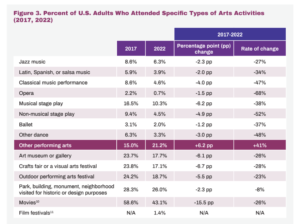
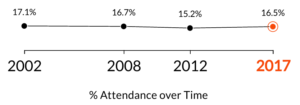
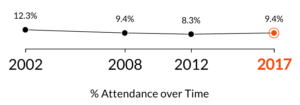

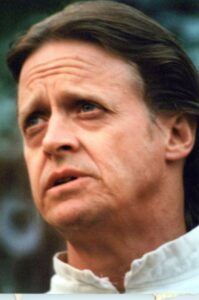
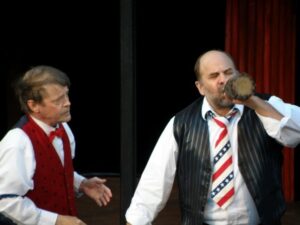
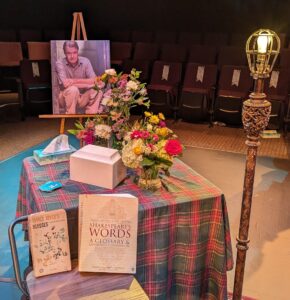





 I did receive a Career Achievement Award at the Buffalo Arties in June, which was wholly and completely unexpected. I was honored for both my 30-year career in the community and also my career as an educator at Fredonia. It was kind of a shock, to be honest. I’m not a fan of awards, and I am not good being at the center of attention, but I got through the ceremony OK. It’s always nice to be appreciated for your work.
I did receive a Career Achievement Award at the Buffalo Arties in June, which was wholly and completely unexpected. I was honored for both my 30-year career in the community and also my career as an educator at Fredonia. It was kind of a shock, to be honest. I’m not a fan of awards, and I am not good being at the center of attention, but I got through the ceremony OK. It’s always nice to be appreciated for your work.


